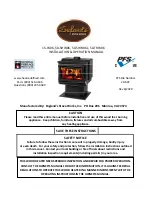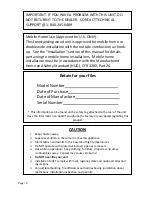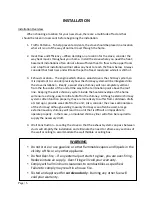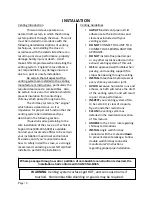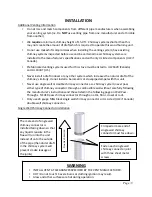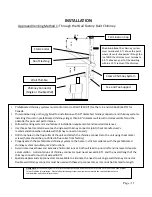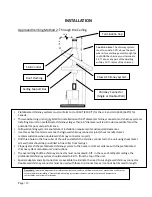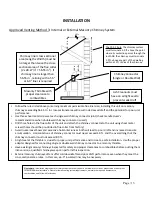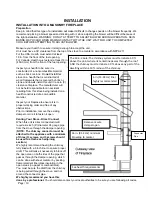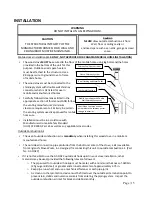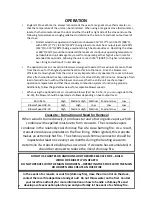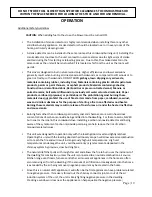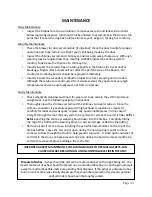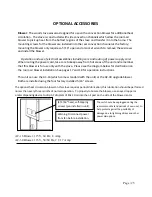
Page | 11
18.
0
in.
2.
0
ft.
3.
0
ft.
INSTALLATION
Approved
Venting
Method
1:
Through
the
Wall
Factory
Built
Chimney
10
ft.
Termination
Cap
Storm
Collar
Roof
Flashing
The
10
‐
3
‐
2
Rule:
The
chimney
system
must
terminate
3.0
ft.
above
the
point
where
its
centerline
passes
through
the
roof
AND
the
chimney
must
terminate
2.0
ft.
above
any
part
of
the
dwelling
within
a
10
ft.
radius
of
the
chimney.
Wall
Thimble
Class
A
Chimney
System
Chimney
Connector
(Single
or
Double
Wall)
Tee
and
Tee
Support
•
Prefabricated
chimney
systems
must
conform
to
UL
‐
103HT
(2100
°F)
for
the
U.S.
and
ULC
‐
S629
(650°C)
for
Canada.
•
This
wood
burning
unit
is
only
listed
for
installation
with
6.0”
diameter
chimney
connector
and
chimney
systems.
Installing
this
unit
on
prefabricated
chimneys
larger
than
6.0”
diameter
will
result
in
decreased
draft
and
the
potential
for
poor
unit
performance.
•
Follow
all
venting
system
manufacturer’s
installation
requirements
and
required
clearances.
•
Use
three
sheet
metal
screws
at
each
single
wall
chimney
connector
joint
(check
manufacturer’s
recommendations
when
double
wall
chimney
connector
is
used).
•
Drill
three
holes
in
the
flue
collar
of
the
unit
and
attach
the
chimney
connector
to
the
unit
using
sheet
metal
screws
(holes
should
be
pre
‐
drilled
in
flue
collar
from
factory).
•
Properly
attach
the
prefabricated
chimney
system
to
the
home
in
strict
accordance
with
the
prefabricated
chimney
system
manufacturer’s
instructions.
•
Avoid
numerous
elbows
and
excessive
horizontal
runs
as
both
will
lead
to
poor
draft
and
increased
creosote
accumulation.
Horizontal
runs
of
chimney
connector
must
never
exceed
4.0
ft.
and
the
overall
length
of
the
chimney
connector
must
not
exceed
8.0
ft.
•
Special
adapters
and
slip
connectors
are
available
to
eliminate
the
need
to
cut
single
wall
chimney
connector.
Double
wall
chimney
connector
must
be
used
with
these
slip
connectors,
as
it
cannot
be
trimmed
to
length.
Please
Note:
Installation
diagrams
are
for
reference
purposes
only
and
are
not
drawn
to
scale,
nor
meant
to
be
used
as
plans
for
each
individual
installation.
Please
follow
all
venting
system
requirements,
maintain
the
required
clearances
to
combustibles,
and
follow
all
local
codes.

